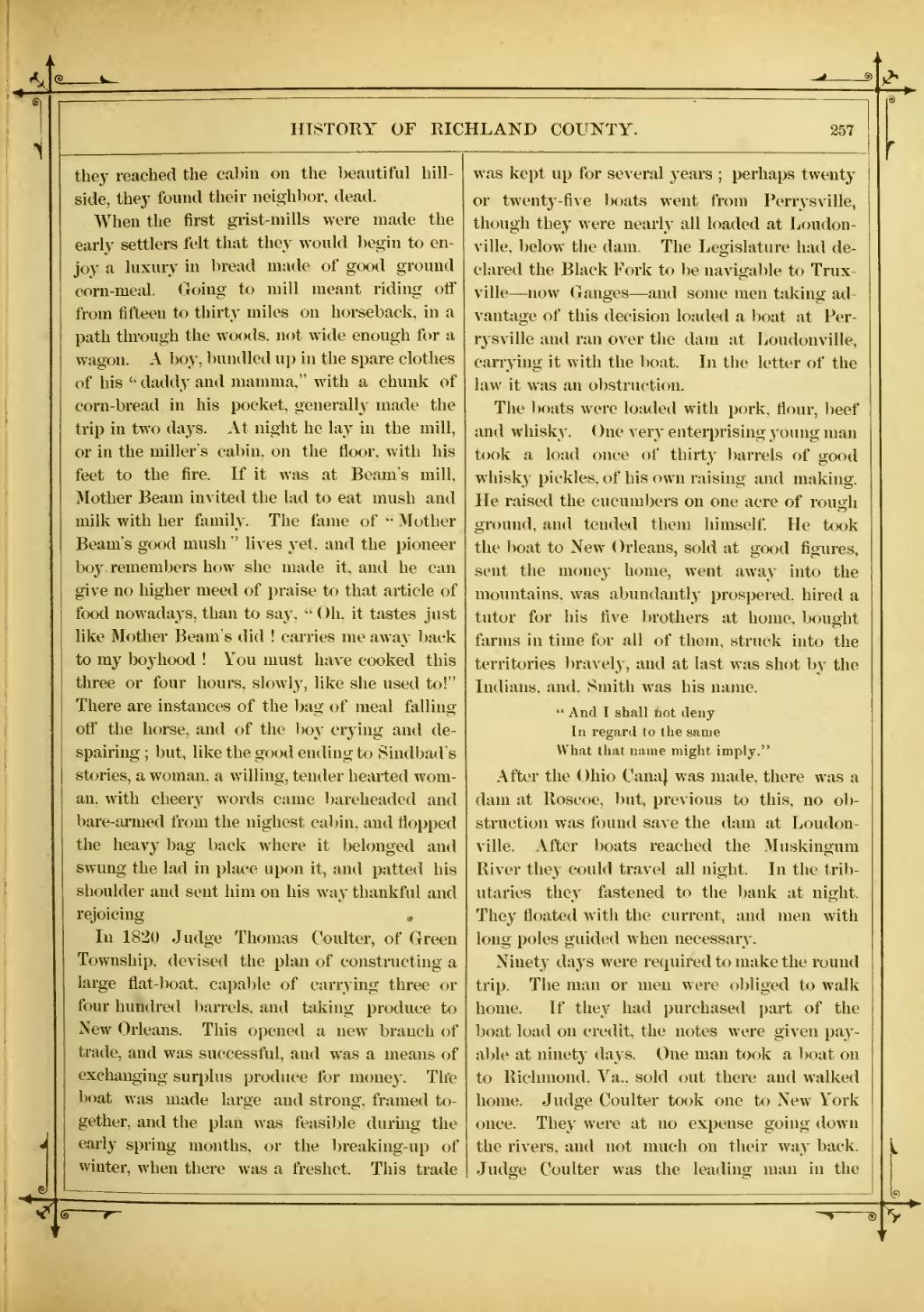HISTORY OF RICHLAND COUNTY.
��257
��they reached the cabin on the beautiful hill- side, they found their neighbor, dead.
When the iirst grist-mills were made the earl}' settlers felt that they would begin to en- jo}^ a luxury in bread made of good ground corn-meal. Going to mill meant riding off from fifteen to thirty miles on horseback, in a path through the woods, not wide enough for a wagon. A boy, bundled up in the spare clothes of his " daddy and mamma," with a chunk of corn-bread in his pocket, generall}- made the trip in two daj'S. At night he la}" in the mill, or in the miller's cabin, on the floor, with his feet to the fire. If it was at Beams mill. Mother Beam invited the lad to eat mush and milk with her family. The fame of " Mother Beam's good mush " lives yet. and the pioneer boy, remembers how she made it. and he can give no higher meed of praise to that article of food nowadays, than to say, •' Oh, it tastes just like Mother Beam's did ! carries me awa}- back to my boyhood ! You must have cooked this three or four hours, slowly, like she used to!" There are instances of the bag of meal fiiUing off the horse, and of the bo}' crying and de- spairing ; but, like the good ending to Sindbad's stories, a woman, a willing, tender hearted wom- an, with cheery words came bareheaded and bare-armed from the nighest cabin, and flopped the heavy bag back where it belonged and swung the lad in place upon it, and patted his shoulder and sent him on his way thankful and rejoicing ,
In 1820 Judge Thomas Coulter, of Grreen Township, devised the plan of constructing a large flat-boat, capable of carrying three or four hundred barrels, and taking produce to New Orleans. This opened a new branch of trade, and was successful, and was a means of exchanging surplus produce for mone}-. Tlfe boat was made large and strong, framed to- gether, and the plan was feasible during the early spring months, or the breaking-up of winter, when there was a freshet. This trade
��was kept up for several years ; perhaps twenty or twentj'-five boats went from Perrysville, though they were nearly all loaded at Loudon- ville, below the dam. The Legislature had de- clared the Black Fork to be navigable to Trux- ville — now Ganges — and some men taking ad- vantage of this decision loaded a boat at Per- rj'sville and ran over the dam at Loudonville, carrying it with the lioat. In the letter of the law it was an obstruction.
The boats were loaded with pork, flour, beef and whisky. One very enterprising young man took a load once of thirty liarrels of good whisky pickles, of his own raising and making. He raised the cucumbers on one acre of rough ground, and tended them himself He took the boat to New Orleans, sold at good figures, sent the money home, went away into the mountains, was abundantlj- prospered, hired a tutor for his five brothers at home, bought farms in time for all of them, struck into the territories bravely, and at last was shot by the Indians, and. Smith was his name.
" And I shall not deny In regard to the same What that name might imply."
After the Ohio Cana). was made, there was a dam at Roscoe, but, previous to this, no ob- struction was found save the dam at Loudon- ville. After boats reached the Muskingum River they could travel all night. In the trib- utaries they fastened to the bank at night. They floated with the current, and men with long poles guided when necessary.
Ninety days were required to make the round trip. The man or men were obliged to walk home. If they had purchased part of the boat load on credit, the notes were given pay- able at ninety days. One man took a boat on to Richmond, Va., sold out there and walked home. Judge Coulter took one to New York once. They were at no expense going down the rivers, and not much on their way back. Judge Coulter was the leading man in the
��-7^
�� �
